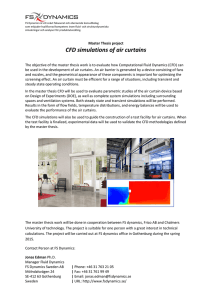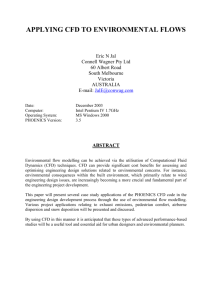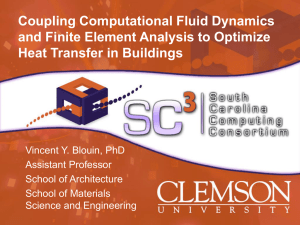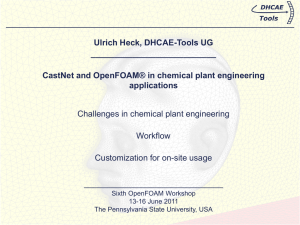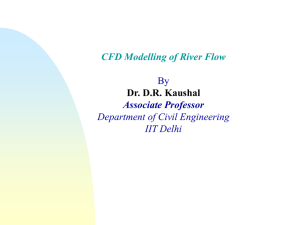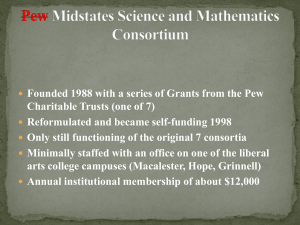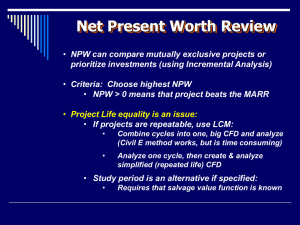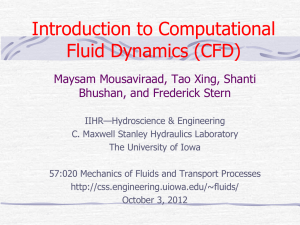SPIE2011 OP408 v2 - Center for Detectors
advertisement
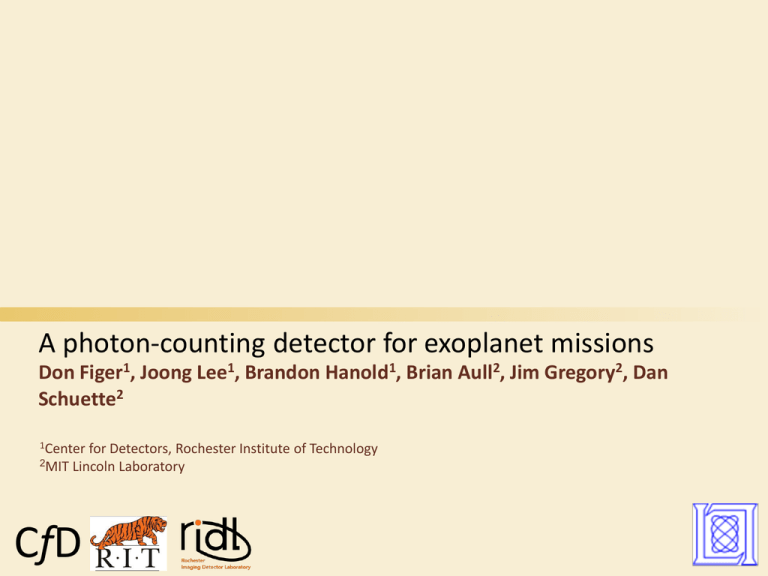
A photon-counting detector for exoplanet missions Don Figer1, Joong Lee1, Brandon Hanold1, Brian Aull2, Jim Gregory2, Dan Schuette2 1Center 2MIT for Detectors, Rochester Institute of Technology Lincoln Laboratory CfD Detector Properties and SNR F tQE S h SNR . N 2 A F tQE A F tQE i t inst N read inst back , dark h h inst A for Q uantum - Limited Detectors, i dark 0 , N read 0 , QE 1 . exposuretimeto reach a particularSNR. Solve SNR equation for t. SNR2 ( N QE n pix N ,background QE n pixidark ) SNR4 ( N QE n pix N ,background QE n pixidark ) 2 4 N 2 n pix (QE N read SNR) 2 2( N QE) 2 SNR 1 and N 0 and idark 0 CfD ,background N read n pix . N QE 2 Exoplanet Imaging Example • The exposure time required to achieve SNR=1 is much lower for a zero read noise detector. read noise FOM 0 1 2 3 4 5 6 7 Exposure Time (seconds) for SNR = 1 Quantum Efficiency 10% 6,600 7,159 8,486 10,148 11,954 13,830 15,745 17,684 20% 2,300 2,674 3,457 4,363 5,312 6,281 7,259 8,244 30% 1,311 1,591 2,141 2,760 3,402 4,053 4,709 5,368 40% 900 1,123 1,547 2,016 2,500 2,990 3,484 3,979 50% 680 865 1,209 1,587 1,976 2,369 2,764 3,161 mag_star=5, mag_planet=30, R=100, i_dark=0.0010 CfD 3 60% 544 703 992 1,309 1,633 1,961 2,291 2,621 70% 453 591 841 1,113 1,392 1,673 1,956 2,239 80% 388 510 730 968 1,212 1,459 1,706 1,954 90% 338 448 645 857 1,074 1,293 1,513 1,734 100% 300 400 577 768 964 1,161 1,359 1,558 Photon-Counting Detectors • Photon-counting detectors detect individual photons. • They typically use an amplification process to produce a large pulse for each absorbed photon. • These types of detectors are useful in low-light and high dynamic range applications – – – – – – CfD nighttime surveillance daytime imaging faint object astrophysics high time resolution biophotonics real-time hyperspectral monitoring of urban/battlefield environments orbital debris identification and tracking 4 Operation of Avalanche Photodiode Linear on Geiger mode mode on Linear Geiger quench mode mode avalanche Current off off arm Vdc + V Vbr CfD Voltage 5 Performance Parameters Single photon input Photon detection efficiency (PDE) The probability that a single incident photon initiates a current pulse that registers in a digital counter APD output Discriminator level Dark count rate (DCR) Digital comparator output The probability that a count is triggered by dark current CfD time time time Successful single photon detection 6 Photon absorbed but insufficient gain – missed count Dark count – from dark current Avalanche Diode Architecture -V hν Quartz substrate p+ implant (collects holes) low E-field 10 µm p+ implant high E-field n+ implant (collects electrons) metal metal metal bump bond ROIC +V CfD 7 0.5 µm Zero Read Noise Detector ROIC metal bump bond pad 2 pixels, 50 m core (active quench, discriminator, APD latch) counters (4 pixels) counter rollover latch 2 pixels, 50 m (left) Floorplan of the unit cell (2×2 pixels) for a previously-designed 256×256 pixel CMOS ROIC. (right) Photograph of this ROIC. Figure 1. CfD 8 8 Zero Noise Detector Project Goals • Operational – Photon-counting – Wide dynamic range: flux limit to >108 photons/pixel/s – Time delay and integrate • Technical – Backside illumination for high fill factor – Moderate-sized pixels (25 m) – Megapixel array CfD 9 Zero Noise Detector Specifications Optical (Silicon) Detector Performance Phase 1 Goal Parameter Format Phase 2 Goal 256x256 1024x1024 25 µm 20 µm zero zero Dark Current (@140 K) <10-3 e-/s/pixel <10-3 e-/s/pixel QEa Silicon (350nm,650nm,1000nm) 30%,50%,25% 55%,70%,35% 90 K – 293 K 90 K – 293 K 100% 100% Pixel Size Read Noise Operating Temperature Fill Factor aProduct of internal QE and probability of initiating an event. Assumes antireflection coating match for wavelength region. CfD 10 Zero Noise Detector Specifications Infrared (InGaAs) Detector Performance Phase 1 Goal Parameter Format Phase 2 Goal Single pixel 1024x1024 25 µm 20 µm Read Noise zero zero Dark Current (@140 K) TBD <10-3 e-/s/pixel QEa (1500nm) 50% 60% 90 K – 293 K 90 K – 293 K NA 100% w/o lens Pixel Size Operating Temperature Fill Factor aProduct of internal QE and probability of initiating an event. Assumes antireflection coating match for wavelength region. CfD 11 Zero Noise Detector Project Status • A 256x256x25m diode array has been bonded to a ROIC. • An InGaAs array has been hybridized and tested. • Testing is underway. • Depending on results, megapixel silicon or InGaAs arrays will be developed. CfD 12 Air Force Target Image CfD 13 Anode Current vs. Vbias and T CfD 14 Dark Current CfD 15 GM APD High/Low Fill Factor CfD 16 GM APD Self-Retriggering Simulated Histogram of Avalanche Arrival Times CfD 17 Radiation Testing Program Overview Building Radiation Testing Program • Simulate on-orbit radiation environment – choose relevant mission parameters: launch date, mission length, orbit type, etc – Determine radiation spectrum (SPENVIS) • Transport radiation particles through shielding to estimate the radiation dose on the detector (GEANT4) • Choose beam properties • Design/fab hardware • Obtain baseline data (pre-rad) • Expose to radiation • Obtain data (post-rad) CfD 19 Mission Parameters • 2015 launch date, 5 and 11 year mission durations • Radiation flux depends on relative phasing with respect to solar cycle • Choose representative mission parameters specific to each type of orbit – – – – L2 Earth Trailing Heliocentric Distant Retrograde Orbits (DRO) Low Earth Orbit (LEO) – 600 km altitude (TESS) • Solar protons – ESP model – Geomagnetic shielding turned on • Trapped e- and p+ – – – – CfD Inside radiation belt AP-8 Min (proton) model AE-8 Max (electron) model Over-predicts flux at high confidence level setting (from SPENVIS HELP page) 20 Orbits Sun-Earth Rotating Frame DRO Earth Trailing Earth DRO 700,000 ± ~50,000 km radius from Earth Propagated ~10 years SIRTF Earth Launch C3 ~ 0.05 km2/s2 185 km altitude 28.5° inclination DRO Insertion ~196 Days + L Delta-V ~150 m/s Sun L2 Earth WMAP CfD 21 GIMLI Top View (North Ecliptic View) Integrated Particle Fluence DRO L2 LEO Earth Trailing CfD 22 Total Ionizing Dose and Non-Ionizing Dose (at L2) CfD 23 Radiation Testing Program • Now that we know the radiation dose the detector is likely to see, we need to build a radiation testing program that is going to simulate the radiation exposure on orbit • We need to choose right beam parameters • Energy, dose rate, particle species • Then, choose radiation facility based on factors above as well as our hardware setup requirements • Vacuum, cryogenics, electrical • We make measurements of relevant quantities pre-, during, post-irradiation to characterize change in detector performance CfD 24 Beam Parameters • We want to expose the device to 50 krad (Si). • Due to practical considerations, we can only irradiate the device with a mono-energetic beam. • A device subjected to 50 krad would see 1.18e9 MeV/g of displacement damage dose (DDD) on orbit at L2. • Ideally, a 50 krad exposure to the proton beam should also yield a DDD of 1.18e9 MeV/g to simulate condition on orbit. • For 60 MeV proton beam, the corresponding DDD to a 50 krad exposure is 1.26e9 MeV/g. CfD 25 Beam Parameters • 60 MeV happens to be where the proportionality between TID and DDD on-orbit is preserved – This depends on thickness of shielding. But if we choose energy around 60 MeV, the proportionality should be more or less preserved. • Dose Rate – MIL Std 883 Test Method 1019 recommends 50 to 300 rad/sec, although this is for gamma ray beam – 50 rad/sec will still allow us to complete a radiation exposure run in reasonable amount time (~17 min.) – It makes sense to follow this as higher the rate more chance the device breaks and for dosimetry reasons CfD 26 Estimate of Induced Dark Current • KDE = JD/ED =q/(A*)*Kdark= 2.09 nA/cm2/MeV at 300 K – This gives conversion formula to convert ED to density – Kdark=(1.9±0.6)105 carriers/cm3/sec per MeV/g silicon (Srour 2000) current for • This is for one week after exposure – A = 6.25*10-6 cm2 – = 2.33 g/cm3 – q = 1.6*10-19 C • For 50 krad exposure to 60 MeV proton beam is ED is 16.05 MeV • Mean Dark Current = KDE ED = 33.5 nA/cm2 at 300 K • Or, Mean Dark Current = 2.25 fA/pixel = 14000 e-/pixel/sec at -20 °C (one week after exposure) 0.63eV 1 1 2 2 At - 20 C, exp ( ) 33 . 5 nA / cm 0 . 36 nA / cm 5 8.617 10 eV / K 253K 300K CfD 0.36nA / cm2 ( 25m ) 2 2.25fA/pixel 27 Test Hardware CfD 28 Conclusions • We have developed, and are testing, a 256x256 photon-counting imaging array detector. • After lab characterization, we will expose four devices to radiation beam and then re-test. CfD 29 Detector Virtual Workshop • Year-long speaker series dedicated to future advanced detectors • Talks streamed and archived • Email if interested in being on distribution list: figer@cfd.rit.edu CfD 30

